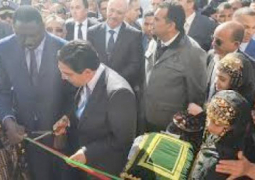Perpetua Katepa-Kalala, Food and Agriculture Organization (FAO) Representative in The Gambia, has eulogised The Gambia’s Community Forest Management (CFM) initiative, saying it has made giant strides towards forest landscape protection and management over the years.
According to her, the Government of The Gambia over the years has demonstrated its commitment through the formulation of appropriate forest policy frameworks and development of strategies since 1995.
Among these strategies is adoption of the first Forest Policy, the Participatory Forest Management Concept (PFMC) and approach as enshrined in The Gambia Forest Management Concept (GFMC), she said.
Madam Kalala made these remarks at the signing and handing over of the Community Forest Management Agreements (CFMAS) to 56 local communities, to legally mandate them to own and manage forest parks to improve livelihoods and sustainable resource management, at a ceremony held at the education conference hall in Janjangbureh, Central River Region.
“FAO Forest and Farm Facility (FFF) project will up to 2017 continue to promote government cross-sect oral coordination and further enhance the organization and capacity of local people and communities so that they can engage in policy dialogues and decision making processes concerning the management of forest landscapes at all level,” the FAO representative said.
All these initiatives are intended to contribute to the global and national efforts towards the eradication of hunger and reduction of poverty, she said, adding that “sustainable development and forest resources are among the most biologically productive ecosystems with unique environmental and economic benefits to man for sustainable development”.
Madam Kalala also said the level of forest degradation globally is estimated to be high due to illegal logging, expansion of agricultural lands in virgin forestland, rampant and unconditional forest fires coupled with unfavorable policy and legal frameworks for popular participation in the management of the resources.
This phenomenon is more severe in Sub-Saharan Africa, she said, adding: “The most important functions of Gambia forest cover are their biomass materials for the food web, reduction in excessive amounts of erosion, the protection of the river banks, habitat for wildlife, ecotourism and sink for carbon dioxide, just to name a few.”
The FAO Representative used the opportunity to urge community forest management committees and their local communities to abide by the terms and conditions attached to the management agreements for the benefit of all and sundry.
Dr Kalala commended the Government of The Gambia through the Honorable Minister of Environment Pa Ousman Jarjue, for the “noble initiative” to handover an estimated five thousand, three hundred and thirty-five hectare (5,335 ha) of forests to local communities in five administrative regions of the country.
She also commended the Ministry of Agriculture and National Resource Working Group and Platform, Forest and Farm Producer Organizations (FFPOs) Regional Community Forest Task Teams, and FFF National Facilitator for re-activating the processes of Community Forest Designation processes and to FAO FFF coaching team alongside FFF partners, such as IIED and IUCN, for their unflinching support.





